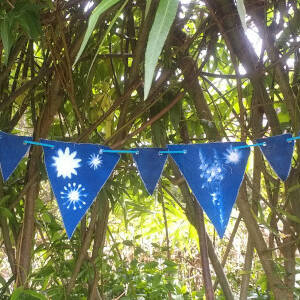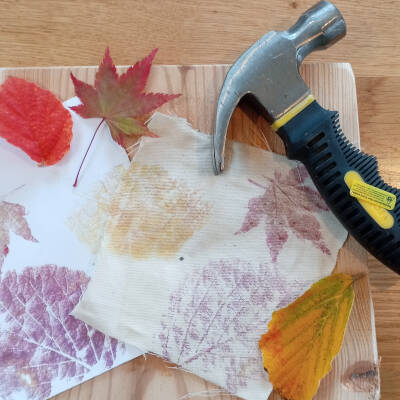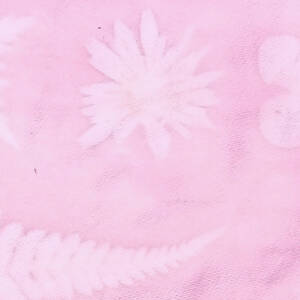Making prints with sun print paper
A simple children's science activity - watch the magic of cyanotype using sun print paper to create some amazing prints.
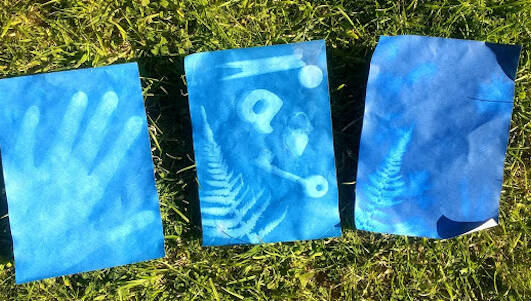
Introduction
Cyanotype is a photographic printing process that uses the sun to create wonderful cyan-blue prints.
* Muddy Faces actively promotes child-led outdoor play & learning. We recognise and believe in the curiosity that children have and their drive to explore and discover. We hope that you will bear this in mind when considering more prescribed activities like this one - often much more creative ideas will occur if resources are simply provided and children are given the time and space to explore independently.
What you'll need
- a sunny day!
- a pack of sun print paper, card or fabric
- a piece of thick cardboard and some pins
- a selection of natural materials/objects
- a waterproof container the size of the print paper
- water
This activity has been provided by
Useful items from our shop
Environmental Considerations
Consider the environmental impact of preparing, carrying out & completing this activity. Could this impact be reduced? Specific considerations for this activity could include:
- leave no trace
- dispose of rinsing water in a mains drainage system
Health & Safety Considerations
Follow your usual operating procedures and carry out appropriate risk benefit assessments.
Some considerations particular to this activity include:
- collecting natural materials
- ferric ammonium citrate and potassium ferricyanide are mild irritants – wear protective gloves
- wash hands after activity
Preparation
Choose a nice sunny day for this activity!
Have everything you need to hand and ready to go – the process starts to happen quickly.
Cyanotype is a printing process that produces a print cyan-blue in colour. Engineers used to use the process as a low-cost way to produce copies of drawings, referred to as blueprints. Two chemicals are used: ferric ammonium citrate and potassium ferricyanide.
How does it work?
The sun-sensitive material is coated with light-sensitive chemicals. When exposed to light the chemicals react to the light waves and particles. When objects are positioned on top, they block the light and the effect the sun has on the chemicals. Water is then used to stop the process and fixes the images. The area protected from the sun by the object will be a pale blue/white and the area exposed to the sun will be a rich colour depending on the type of paper, card or material that you use. The activity below uses sun print paper.
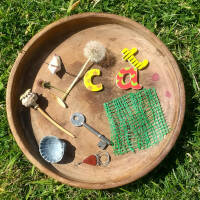
Step #1 gather your objects
Explore your local surroundings and find some FLAT objects to print. You can experiment with non-flat items but the contrast of the print isn’t as clear.
It is good to talk about what the image may look like at this stage and to discuss how the sun paper works.
You could have a basket of objects like keys, buttons or lace to experiment with.
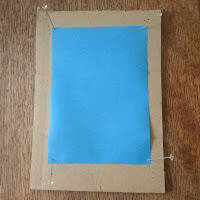
Step #2 prepare your sun-sensitive paper
Have your items to hand so you can place them quickly, ideally whilst you are in the shade.
Remove a sheet of the sun-sensitive paper from the pack (BLUE SIDE UP) and pin it in each corner to the piece of cardboard. This will hold the paper in place and stop it from being blown away.
Alternatively, you can place the paper in a high-sided container for wind protection.
NB If you use thumbtack-style pins you will get small circle prints in each corner. Using needlework pins will reduce this effect.
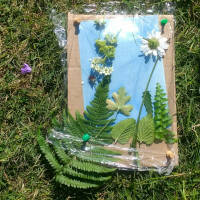
Step #3 arrange your objects
Arrange the objects on top of the sun-sensitive paper – ideally you’ll be in the shade and/or act quickly – as soon as the paper is exposed to the sun it will begin to react and will leave the background of the finished print a lighter shade of blue (see hand in main photo at top).
Tip: If you want to use lightweight items like feathers you can cover the whole thing with clingfilm or a piece of clear plastic (like an acetate sheet that might be lurking at the back of a store cupboard!) instead of using pins. You could also punch holes in the corner of the acetate (cut to the size of the sun-sensitive paper) and pin the whole lot together.
Tip: Place the sun paper/card/container on a raised surface to prevent items being knocked off the paper; particularly if you are doing this with very young children.
Tip: Adjust the position to minimise shadows that are cast from more solid objects.
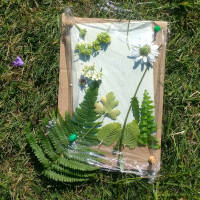
Step #4 expose the paper
Carefully move your paper and arranged objects into direct sun.
Expose the paper to strong sunlight until the blue paper turns a very pale blue. This will take 2-5 minutes or you may need to leave it longer depending on the intensity of the sun.
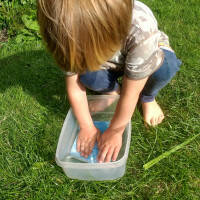
Step #5 stop the process
Remove the objects from the paper and whilst protecting the print from direct sun soak it in a container of water for about 1 minute.
NB Any image will disappear whilst the paper is soaking and then will gradually reappear towards the end of the minute.
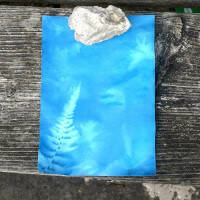
Step #6 dry the paper
Dry the print flat. The images will sharpen during drying time.
If it is windy weigh down the print to stop it blowing away.
Amazing results!!
NB The paper will go a bit wrinkly; try blotting the excess water first with a cloth.
Take it further:
- experiment with a range of objects, light sources and exposure time
- cut the prints out and make a collage or make a card for someone
- make some amazing sun print bunting!
Disclaimer: Muddy Faces cannot take any responsibility for accidents or damage that occurs as a result of following this activity.You are responsible for making sure the activity is conducted safely.
Key Features
- Age Range All Ages
- Duration Less than an hour
- Location Anywhere
- Season Summer
-
Categories:
Art & Creating
sun print
Activity Downloads
